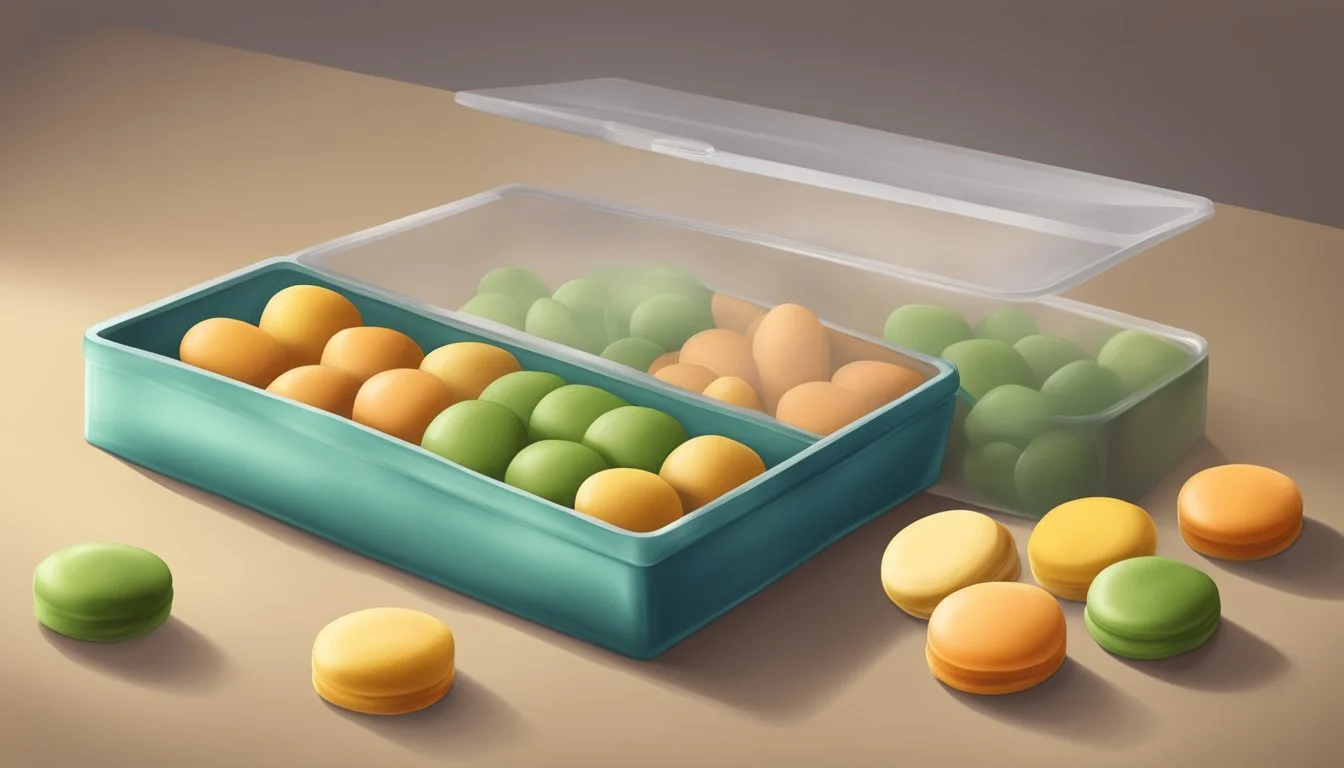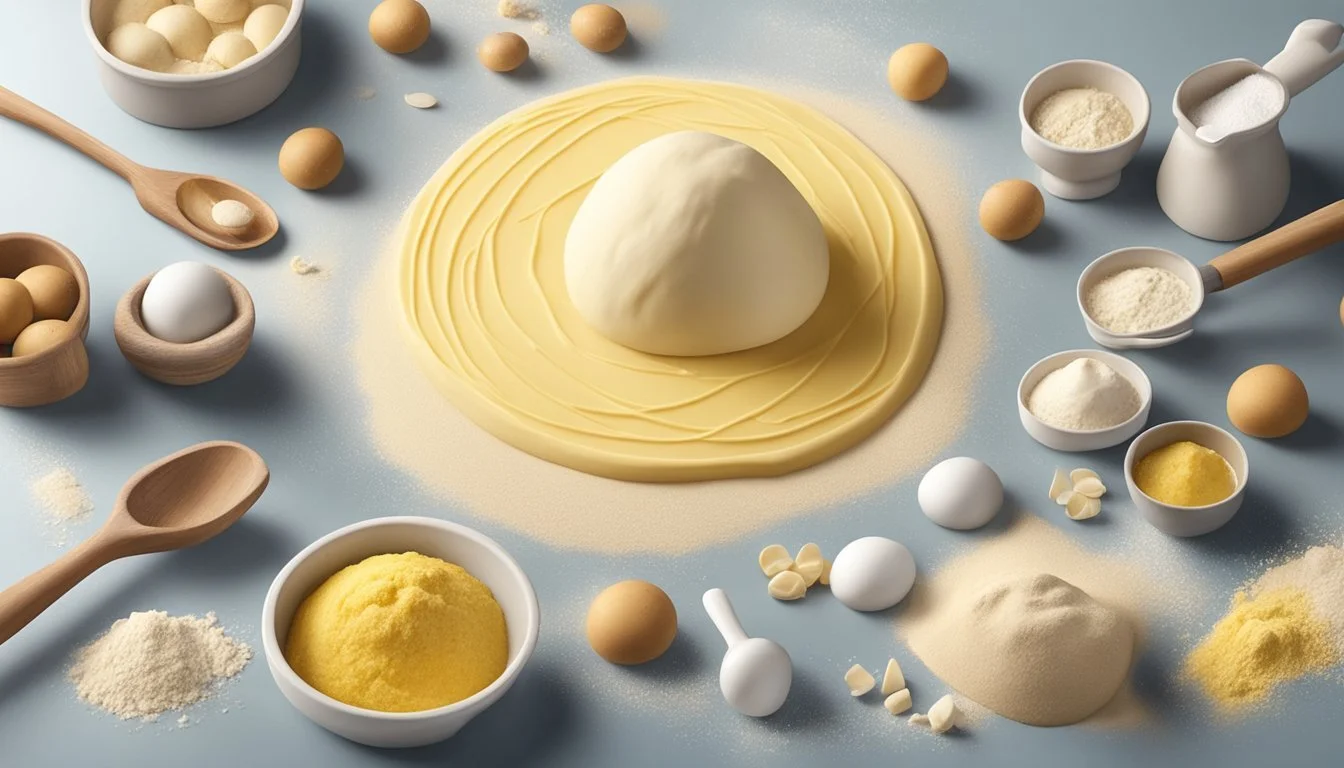Does Marzipan Go Bad?
Shelf Life and Spoilage Signs
Marzipan, a confection consisting predominantly of sugar or honey and almond meal, is enjoyed worldwide for its sweet, nutty flavor and its versatile use in baking and candy making. Concerns about the shelf life and quality of marzipan are common, especially considering its high sugar content, which typically acts as a preservative. Despite this, marzipan can indeed lose its freshness and become stale if not stored correctly.
Storage conditions play a crucial role in maintaining the quality of marzipan. To preserve its soft texture and almond flavor, it should be wrapped tightly and kept away from heat and moisture. When stored at room temperature in a cool, dark place, marzipan with higher sugar concentrations can last several months. However, exposure to air and light can cause it to dry out and harden, reducing its quality and shelf life.
For extended preservation, refrigeration and freezing are effective methods. When refrigerated properly, marzipan can maintain its quality for up to a year. Freezing extends this time frame even further, potentially keeping marzipan fresh for up to two years. It’s important to note that the marzipan’s composition, including the ratio of almonds to sugar, can affect its longevity, with some varieties having shorter shelf lives than others.
Understanding Marzipan
Marzipan is a confection primarily composed of sugar and almond meal, which gives it a soft and pliable texture. Its versatility has made it a staple in various culinary traditions, particularly in Europe, where it's a popular treat during Christmas and other celebrations.
Composition and Varieties
Marzipan's base ingredients are almond meal and sugar, often enriched with almond extract to enhance the flavor. The ratio between almonds and sugar can vary, which affects the marzipan's texture. Some variations also include egg whites, which act as a binder. Marzipan's cousin, almond paste, has a higher proportion of almonds and is coarser in texture.
Almond meal to sugar ratio:
Traditional marzipan: Roughly 1:1 almond to sugar.
Almond paste: Higher almond content.
Historical Significance
Marzipan's origins are debated, with claims from Germany, Italy, and the Middle East. Regardless of its true origin, marzipan became widely appreciated in Europe, with Germany and Italy touting their unique regional variations. It has been crafted since the Middle Ages, reflecting the delicacy’s important cultural heritage.
Countries with strong marzipan traditions:
Germany: Famous for its marzipan "Lübecker" from the city of Lübeck.
Italy: Known for "marzapane", used in traditional treats like Frutta Martorana.
Culinary Uses
Marzipan is celebrated for its flexible use in desserts. It can cover cakes as a smooth layer or be shaped into pastries and candy. Some European cultures use it as a substitute for fondant to decorate cakes, while around Christmas, marzipan is often crafted into festive shapes. The use of marzipan extends to being a filling in specialty pastries, providing a delicate almond sweetness.
Examples of marzipan in desserts:
As a covering for wedding and Christmas cakes.
Shaped into fruits, animals, or other intricate designs for candies.
A filling for pastries like stollen or Battenberg cake.
Shelf Life and Expiration
Marzipan's shelf life can span from several months up to a year or more depending on storage conditions, with store-bought varieties typically featuring an expiration date.
Factors Influencing Shelf Life
Storage: Marzipan should be kept in a cool, dry place if unopened and in a refrigerator if opened.
Unopened store-bought: 6-12 months in a cool, dry place.
Opened: 2-4 weeks in the refrigerator.
Homemade: Less preservatives suggest a shorter shelf life, typically a few weeks.
Packaging: Tight wrapping, particularly for freezer storage, can extend the shelf life considerably.
Frozen: Properly wrapped it can last beyond the typical shelf life.
Ingredients: The primary components, almonds and sugar, provide a naturally extended shelf life due to their low moisture content, which is conducive to preservation.
Preservatives: Store-bought marzipan often contains preservatives that extend its shelf life beyond homemade versions.
Identifying Signs of Spoilage
Observing marzipan for changes is key to determining if it has spoiled.
Color and Texture: Look for any discoloration or changes in texture. Marzipan should be pliable; a hard texture indicates it's no longer fresh.
Fresh: Even coloration and smooth, pliable consistency.
Spoiled: Discoloration, hardening, or drying out.
Odor and Flavor: A fresh marzipan has a pleasant almondy scent and sweet taste.
Fresh: Sweet, nutty aroma.
Spoiled: Off-putting or stale odor may indicate spoilage.
Mold: Any presence of mold signifies that the marzipan should be discarded.
Fresh: Free of mold.
Spoiled: Visible mold growth.
Proper Storage Techniques
Maintaining the quality of marzipan is contingent on effective storage methods. Attention to temperature, environment, and the duration of storage is paramount to prevent spoilage.
Temperature and Environment
Marzipan is best kept in a cool, dark place to retain its freshness. Exposure to high temperatures or direct sunlight can lead to a breakdown in texture and taste. The ideal environment should be dry since moisture can cause marzipan to degrade quicker. Keeping marzipan in an airtight container is essential to protect it from humidity and external odors.
Suggested storage locations: Pantry or cupboard
Recommended conditions: Cool, dry, dark, and away from strong odors
Short-Term vs. Long-Term Storage
Short-Term Storage: Marzipan used within a month can be stored at room temperature, enveloped in cling wrap or plastic wrap, and placed in an airtight container to shield it from air and moisture.
Duration: Up to 1 month
Method:
Wrap in plastic wrap
Place in an airtight container
Long-Term Storage: For durations extending beyond a month, marzipan should be refrigerated or frozen. If opting for refrigeration, marzipan can last up to 6 months when properly wrapped and stored. Freezing marzipan will extend its longevity up to 2 years. Marzipan stored in the freezer should be wrapped in plastic to prevent freezer burn, and stored in a freezer-safe bag or container.
Refrigeration:
Duration: Up to 6 months
Wrap tightly in plastic; use an airtight container
Freezing:
Duration: Up to 2 years
Wrap well in plastic; transition to freezer-safe bag or container
Marzipan in Baking and Cooking
Marzipan, a confection consisting primarily of sugar or honey and ground almonds, is a versatile ingredient in both baking and cooking, imparting a nutty flavor and malleable texture to a myriad of dishes.
Integrating Marzipan into Recipes
In baking, chefs often use marzipan as an icing, especially for traditional cakes like the Battenberg, lending a rich, nutty flavor to the sponge layers. Marzipan's pliability makes it ideal for incorporating into various recipes. To infuse this almond paste into baked goods, one can fold small pieces into batter, creating a subtle almond essence within cakes or cookies. Alternatively, marzipan can be rolled flat and used as a layer within pastries, where it acts as a flavorful barrier, adding sweetness and trapping moisture.
For those who enjoy experimentative cooking, marzipan can even be used as a filling for sweet bread or as a component in fruit pies, complementing the tartness of the fruit with its sweet, nutty flavor. Here is a concise guide on how to integrate marzipan into recipes:
Flatten marzipan and use as a cake layer
Dice marzipan and fold into batter or cookie dough
Roll into decorative shapes and bake as cookies
Mold around fruit to create marzipan fruits
Decorative Aspects
Besides its use in recipes, marzipan is notable for its decorative aptitude in cooking. Its malleability allows for crafting intricate decorative shapes, such as fruits, animals, or flowers, often used to adorn cakes and desserts. For an aesthetic flourish, pastry chefs can color marzipan with food coloring, shape it, and then paint it with a fine brush to mimic the natural nuanced hues of the shapes they are representing. Additionally, adding flavorings like rose water can enhance the taste of the decorations, tailoring them to the specific palette of the dessert.
To create a variety of decorations, marzipan can be handled as follows:
Shape: Mold by hand into fruits, flowers, or figures.
Color: Use food dyes to match the marzipan decor to the theme of the dessert.
Flavor: Infuse with rose water or other essences to pair with the overall dessert profile.
In sum, marzipan's adaptability in the kitchen extends beyond its taste, and its decorative potentials are bound only by the chef's creativity. Whether used as icing, an ingredient, or a decorative touch, marzipan elevates the flavor and appearance of countless dishes within the culinary arts.
Health and Safety Concerns
Marzipan is typically safe to consume, even past its expiration date when properly stored. However, like any food product, it can become unsafe due to spoilage or contamination.
Food Safety Guidelines
Storage: To prevent spoilage, marzipan should be stored in a cool, dry place and tightly sealed. Refrigeration can extend its life, but it should be well wrapped to prevent moisture buildup. As a guideline:
Room temperature: Up to 1 month
Refrigerated: Up to 6 months
Freezer: Up to 3 years (if properly stored in an airtight container)
Signs of Spoilage:
Mold growth: Visible mold indicates that marzipan has become inedible and should be discarded immediately.
Texture: A hard or dry texture suggests deterioration.
Scent: Any off-putting or unusual odor signals that the marzipan may not be safe to eat.
Egg Whites: Some marzipan recipes include egg whites, which can raise food safety concerns, particularly if they are raw or improperly stored, increasing the risk of food poisoning from bacteria like Salmonella.
Glucose and Sugar: While high sugar content can act as a preservative, it does not make the product immune to spoilage. If the marzipan contains glucose syrups, consumers should ensure it has been stored under recommended conditions to avoid degradation.
Allergens and Dietary Restrictions
Ingredients to Note:
Almonds: Marzipan's primary ingredient is almonds, a common allergen.
Pistachios: Occasionally, marzipan may also contain pistachios, another allergen.
Eggs: As mentioned above, egg whites may be a part of the marzipan mixture and can pose a risk to those with egg allergies.
Individuals with allergies or dietary restrictions should always check marzipan's ingredient list and should be cautious about potential cross-contamination if they have severe allergies to any of the ingredients typically found in marzipan.
Advanced Preservation Methods
When it comes to extending the shelf life of marzipan, advanced preservation methods can be employed to maintain its quality over extended periods. These include the use of chemical preservatives and cryogenic freezing techniques.
Using Preservatives
Marzipan's longevity can be enhanced by incorporating preservatives that inhibit microbial growth and prevent quality degradation. Specifically, glucose syrup can serve as a humectant preservative to retain moisture and reduce drying out. The addition of glucose syrup helps maintain the pliable texture of marzipan. When adding preservatives, it is crucial to follow the correct proportions as outlined by food safety regulations to ensure that the marzipan remains safe for consumption.
Cryogenic Freezing
Freezing marzipan can be taken a step further through cryogenic freezing methods. To freeze marzipan using this advanced technique, it should be wrapped in a sealed package to protect it from freezer burn and flavor loss. The marzipan should be frozen rapidly to extremely low temperatures, which preserves its quality by inhibiting the formation of ice crystals which can affect texture upon thawing. When it's time to use the marzipan, proper thawing techniques should be employed, such as gradually defrosting in the refrigerator to ensure the product maintains its integrity.
Cultural and Regional Variations
Marzipan is a versatile confection enjoyed in various forms around the world, and it plays a significant role in holiday traditions in many cultures. Its consistency and suitability for molding make marzipan a beloved sweet treat for both everyday and festive occasions.
Marzipan Across the World
Germany and Austria: Known for producing some of the most intricate marzipan figures, these countries have elevated the confection to an art form. Lübeck, a city in Germany, is renowned for its high-quality marzipan and often is credited with the confection's invention. The insistence on using pure almond paste sets their standard apart.
Venice: A historical center of marzipan production, Venice has its own distinct version of this confection. Like many Italian treats, the Venetian take on marzipan involves shaping the almond paste into fruits and other shapes, often with bright colors and detailed artistry.
United States: The presence of marzipan in the United States is heavily influenced by European immigrants. It's less common as an everyday sweet but serves as a decorative element on cakes or as a festive treat during specific holidays such as Christmas and Easter.
Holiday Traditions Involving Marzipan
Christmas: In many cultures, marzipan figures and shapes become prominent as Christmas approaches. They are used as ornaments, stocking stuffers, and as the essential component in holiday desserts like stollen or as a decorative element on seasonal cakes.
Easter: During Easter, marzipan is often shaped into eggs or chicks, serving as both decoration and dessert. It is a tradition that can be found across various cultures, from the intricate marzipan lambs in Europe to the simplest of almond paste bunnies in the United States.








